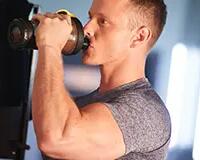Learn the basic multi-joint movements that are the mainstays of weight training: squat patterns, hip extensions, push patterns, pull patterns.
I'd recommend learning these movements, but not training on them (training in this case means using heavy weights).
You should master these movements, which are the basic movements for any weight training programme, before starting to use the weights themselves.It's a key step. You need to build a solid foundation before moving on to step n°3.
If you don't perform these basic movements well, you'll get into bad habits and risk injuring yourself. To avoid this, you need to be able to perform a squat correctly, a hip extension properly, a push to the front and above yourself with the right muscle tension, and a pull towards yourself and downwards without injuring yourself.
I would recommend the 12-week programme in the Decathlon My Coach app, which also happens to be free! This programme is based on the basic movements and will give you all the advice you need to perform these moves perfectly and see real progress as the weeks go by.


